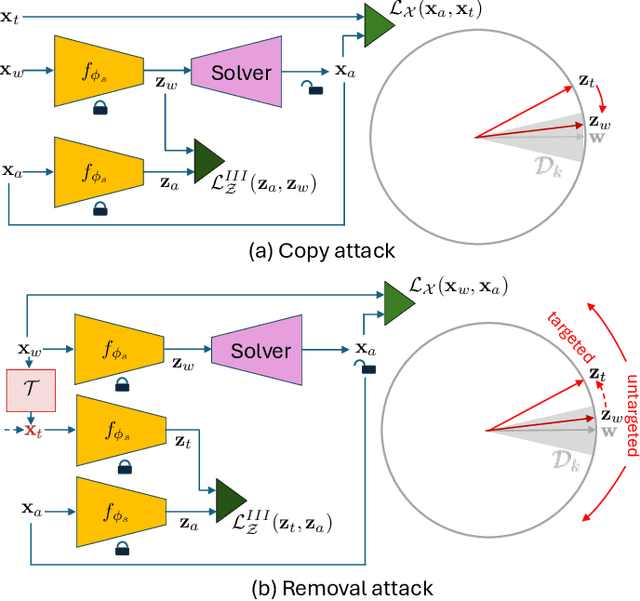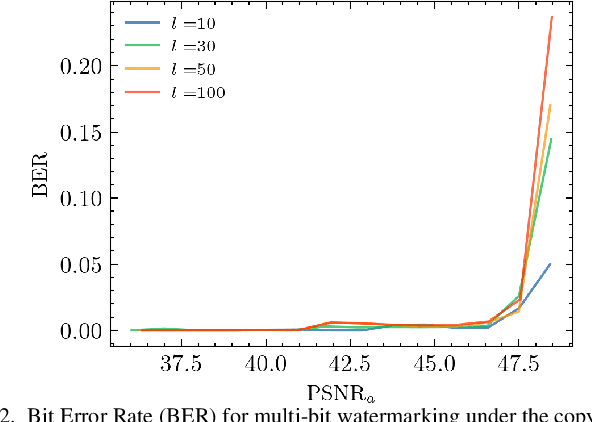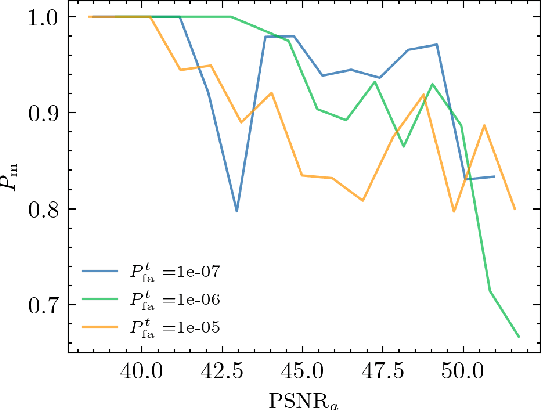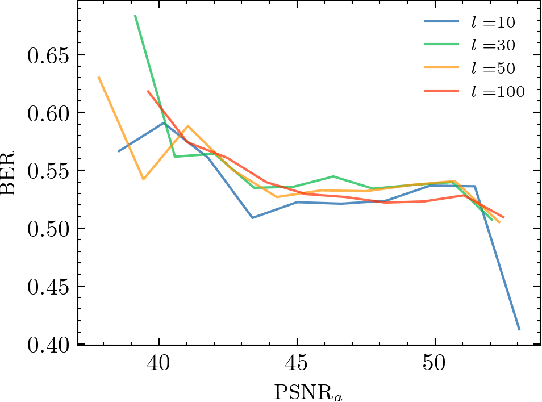Brian Pulfer
Robustness Tokens: Towards Adversarial Robustness of Transformers
Mar 13, 2025Abstract:Recently, large pre-trained foundation models have become widely adopted by machine learning practitioners for a multitude of tasks. Given that such models are publicly available, relying on their use as backbone models for downstream tasks might result in high vulnerability to adversarial attacks crafted with the same public model. In this work, we propose Robustness Tokens, a novel approach specific to the transformer architecture that fine-tunes a few additional private tokens with low computational requirements instead of tuning model parameters as done in traditional adversarial training. We show that Robustness Tokens make Vision Transformer models significantly more robust to white-box adversarial attacks while also retaining the original downstream performances.
* This paper has been accepted for publication at the European Conference on Computer Vision (ECCV), 2024
Task-Agnostic Attacks Against Vision Foundation Models
Mar 05, 2025Abstract:The study of security in machine learning mainly focuses on downstream task-specific attacks, where the adversarial example is obtained by optimizing a loss function specific to the downstream task. At the same time, it has become standard practice for machine learning practitioners to adopt publicly available pre-trained vision foundation models, effectively sharing a common backbone architecture across a multitude of applications such as classification, segmentation, depth estimation, retrieval, question-answering and more. The study of attacks on such foundation models and their impact to multiple downstream tasks remains vastly unexplored. This work proposes a general framework that forges task-agnostic adversarial examples by maximally disrupting the feature representation obtained with foundation models. We extensively evaluate the security of the feature representations obtained by popular vision foundation models by measuring the impact of this attack on multiple downstream tasks and its transferability between models.
Evaluation of Security of ML-based Watermarking: Copy and Removal Attacks
Sep 26, 2024



Abstract:The vast amounts of digital content captured from the real world or AI-generated media necessitate methods for copyright protection, traceability, or data provenance verification. Digital watermarking serves as a crucial approach to address these challenges. Its evolution spans three generations: handcrafted, autoencoder-based, and foundation model based methods. %Its evolution spans three generations: handcrafted methods, autoencoder-based schemes, and methods based on foundation models. While the robustness of these systems is well-documented, the security against adversarial attacks remains underexplored. This paper evaluates the security of foundation models' latent space digital watermarking systems that utilize adversarial embedding techniques. A series of experiments investigate the security dimensions under copy and removal attacks, providing empirical insights into these systems' vulnerabilities. All experimental codes and results are available at https://github.com/vkinakh/ssl-watermarking-attacks}{repository
Mathematical model of printing-imaging channel for blind detection of fake copy detection patterns
Dec 14, 2022Abstract:Nowadays, copy detection patterns (CDP) appear as a very promising anti-counterfeiting technology for physical object protection. However, the advent of deep learning as a powerful attacking tool has shown that the general authentication schemes are unable to compete and fail against such attacks. In this paper, we propose a new mathematical model of printing-imaging channel for the authentication of CDP together with a new detection scheme based on it. The results show that even deep learning created copy fakes unknown at the training stage can be reliably authenticated based on the proposed approach and using only digital references of CDP during authentication.
Solving the Weather4cast Challenge via Visual Transformers for 3D Images
Dec 05, 2022Abstract:Accurately forecasting the weather is an important task, as many real-world processes and decisions depend on future meteorological conditions. The NeurIPS 2022 challenge entitled Weather4cast poses the problem of predicting rainfall events for the next eight hours given the preceding hour of satellite observations as a context. Motivated by the recent success of transformer-based architectures in computer vision, we implement and propose two methodologies based on this architecture to tackle this challenge. We find that ensembling different transformers with some baseline models achieves the best performance we could measure on the unseen test data. Our approach has been ranked 3rd in the competition.
Digital twins of physical printing-imaging channel
Oct 28, 2022Abstract:In this paper, we address the problem of modeling a printing-imaging channel built on a machine learning approach a.k.a. digital twin for anti-counterfeiting applications based on copy detection patterns (CDP). The digital twin is formulated on an information-theoretic framework called Turbo that uses variational approximations of mutual information developed for both encoder and decoder in a two-directional information passage. The proposed model generalizes several state-of-the-art architectures such as adversarial autoencoder (AAE), CycleGAN and adversarial latent space autoencoder (ALAE). This model can be applied to any type of printing and imaging and it only requires training data consisting of digital templates or artworks that are sent to a printing device and data acquired by an imaging device. Moreover, these data can be paired, unpaired or hybrid paired-unpaired which makes the proposed architecture very flexible and scalable to many practical setups. We demonstrate the impact of various architectural factors, metrics and discriminators on the overall system performance in the task of generation/prediction of printed CDP from their digital counterparts and vice versa. We also compare the proposed system with several state-of-the-art methods used for image-to-image translation applications.
Printing variability of copy detection patterns
Oct 11, 2022



Abstract:Copy detection pattern (CDP) is a novel solution for products' protection against counterfeiting, which gains its popularity in recent years. CDP attracts the anti-counterfeiting industry due to its numerous benefits in comparison to alternative protection techniques. Besides its attractiveness, there is an essential gap in the fundamental analysis of CDP authentication performance in large-scale industrial applications. It concerns variability of CDP parameters under different production conditions that include a type of printer, substrate, printing resolution, etc. Since digital off-set printing represents great flexibility in terms of product personalized in comparison with traditional off-set printing, it looks very interesting to address the above concerns for digital off-set printers that are used by several companies for the CDP protection of physical objects. In this paper, we thoroughly investigate certain factors impacting CDP. The experimental results obtained during our study reveal some previously unknown results and raise new and even more challenging questions. The results prove that it is a matter of great importance to choose carefully the substrate or printer for CDP production. This paper presents a new dataset produced by two industrial HP Indigo printers. The similarity between printed CDP and the digital templates, from which they have been produced, is chosen as a simple measure in our study. We found several particularities that might be of interest for large-scale industrial applications.
Anomaly localization for copy detection patterns through print estimations
Sep 29, 2022



Abstract:Copy detection patterns (CDP) are recent technologies for protecting products from counterfeiting. However, in contrast to traditional copy fakes, deep learning-based fakes have shown to be hardly distinguishable from originals by traditional authentication systems. Systems based on classical supervised learning and digital templates assume knowledge of fake CDP at training time and cannot generalize to unseen types of fakes. Authentication based on printed copies of originals is an alternative that yields better results even for unseen fakes and simple authentication metrics but comes at the impractical cost of acquisition and storage of printed copies. In this work, to overcome these shortcomings, we design a machine learning (ML) based authentication system that only requires digital templates and printed original CDP for training, whereas authentication is based solely on digital templates, which are used to estimate original printed codes. The obtained results show that the proposed system can efficiently authenticate original and detect fake CDP by accurately locating the anomalies in the fake CDP. The empirical evaluation of the authentication system under investigation is performed on the original and ML-based fakes CDP printed on two industrial printers.
Authentication of Copy Detection Patterns under Machine Learning Attacks: A Supervised Approach
Jun 25, 2022



Abstract:Copy detection patterns (CDP) are an attractive technology that allows manufacturers to defend their products against counterfeiting. The main assumption behind the protection mechanism of CDP is that these codes printed with the smallest symbol size (1x1) on an industrial printer cannot be copied or cloned with sufficient accuracy due to data processing inequality. However, previous works have shown that Machine Learning (ML) based attacks can produce high-quality fakes, resulting in decreased accuracy of authentication based on traditional feature-based authentication systems. While Deep Learning (DL) can be used as a part of the authentication system, to the best of our knowledge, none of the previous works has studied the performance of a DL-based authentication system against ML-based attacks on CDP with 1x1 symbol size. In this work, we study such a performance assuming a supervised learning (SL) setting.
Mind the Gap! A Study on the Transferability of Virtual vs Physical-world Testing of Autonomous Driving Systems
Dec 21, 2021



Abstract:Safe deployment of self-driving cars (SDC) necessitates thorough simulated and in-field testing. Most testing techniques consider virtualized SDCs within a simulation environment, whereas less effort has been directed towards assessing whether such techniques transfer to and are effective with a physical real-world vehicle. In this paper, we leverage the Donkey Car open-source framework to empirically compare testing of SDCs when deployed on a physical small-scale vehicle vs its virtual simulated counterpart. In our empirical study, we investigate the transferability of behavior and failure exposure between virtual and real-world environments on a vast set of corrupted and adversarial settings. While a large number of testing results do transfer between virtual and physical environments, we also identified critical shortcomings that contribute to the reality gap between the virtual and physical world, threatening the potential of existing testing solutions when applied to physical SDCs.
 Add to Chrome
Add to Chrome Add to Firefox
Add to Firefox Add to Edge
Add to Edge